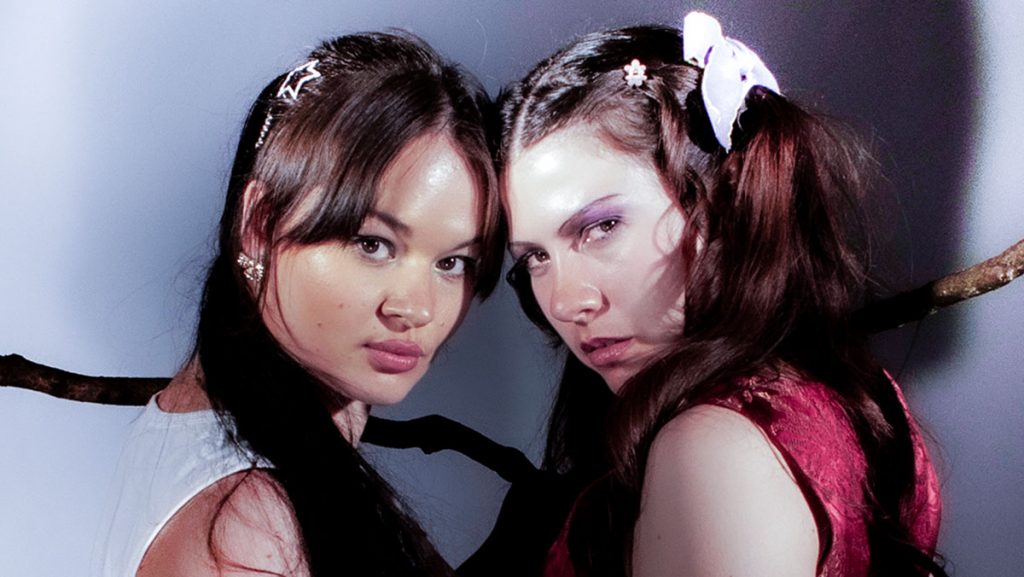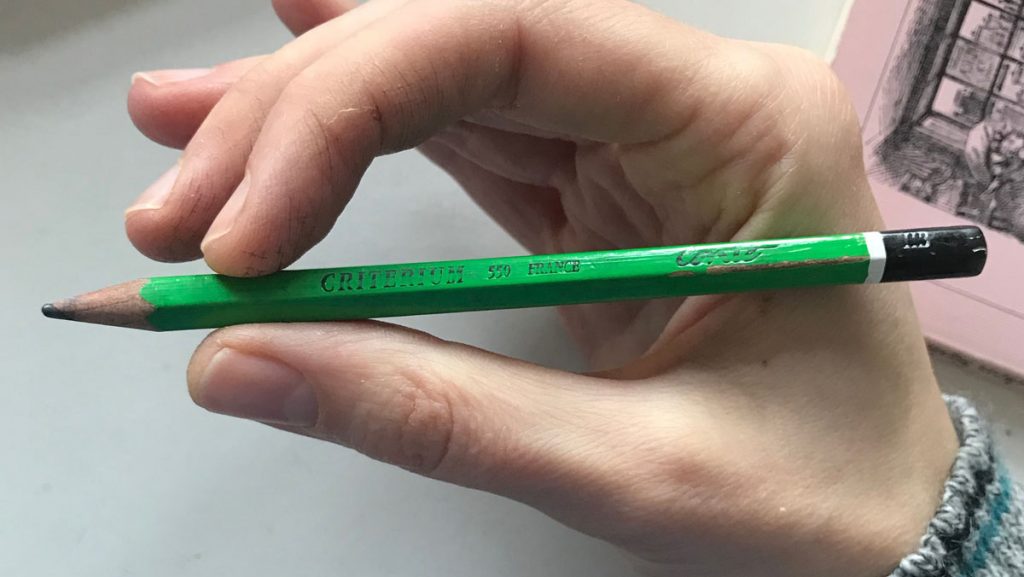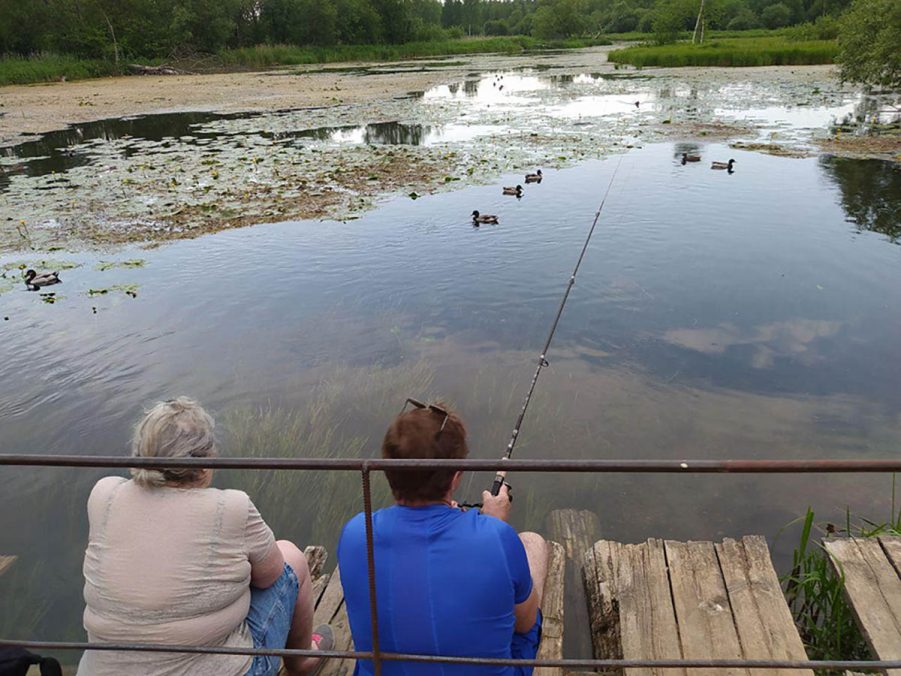
Two women are fishing at the rare Chudo-polyana, Gatchina. Field trip, part of the Chudo-polyana 2.0 project 2020 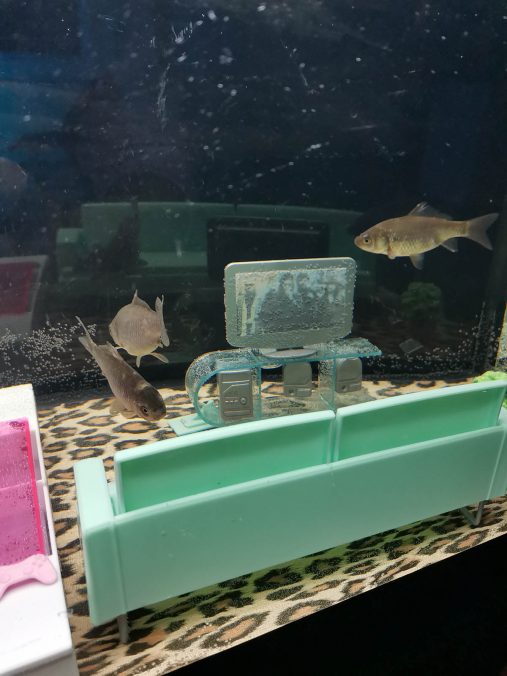
First residents trying out Goldfish, The residential complex 2020. 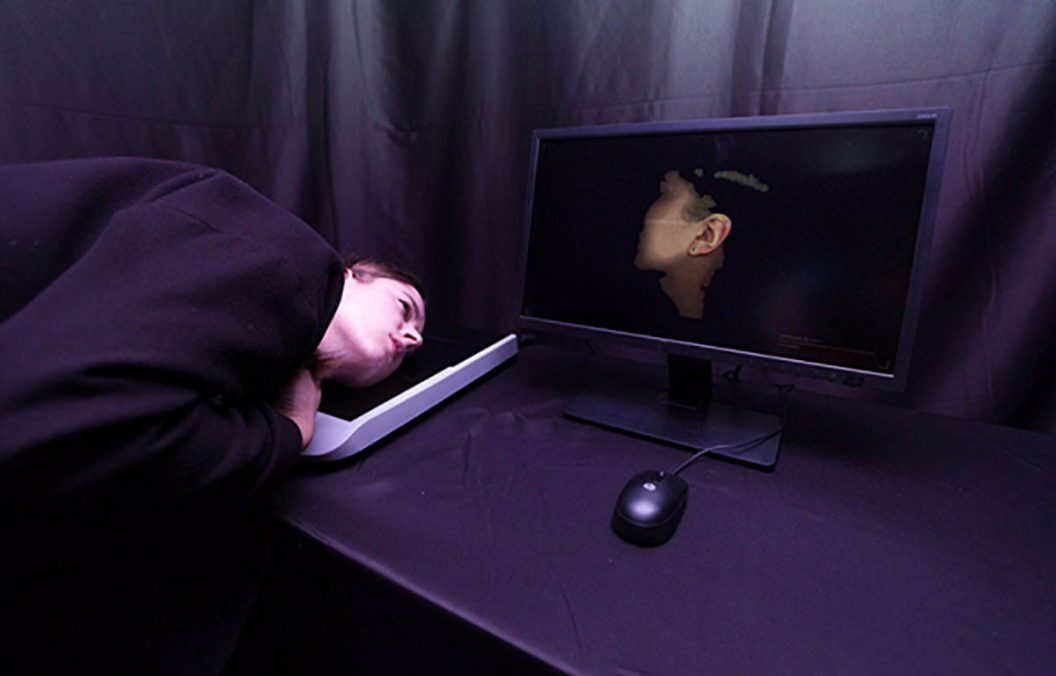
A Sushi BAR & BIOROBOTY 019 Kopie
A visitor is being creative with Physarum-fortuneteller, CYFEST-12 2019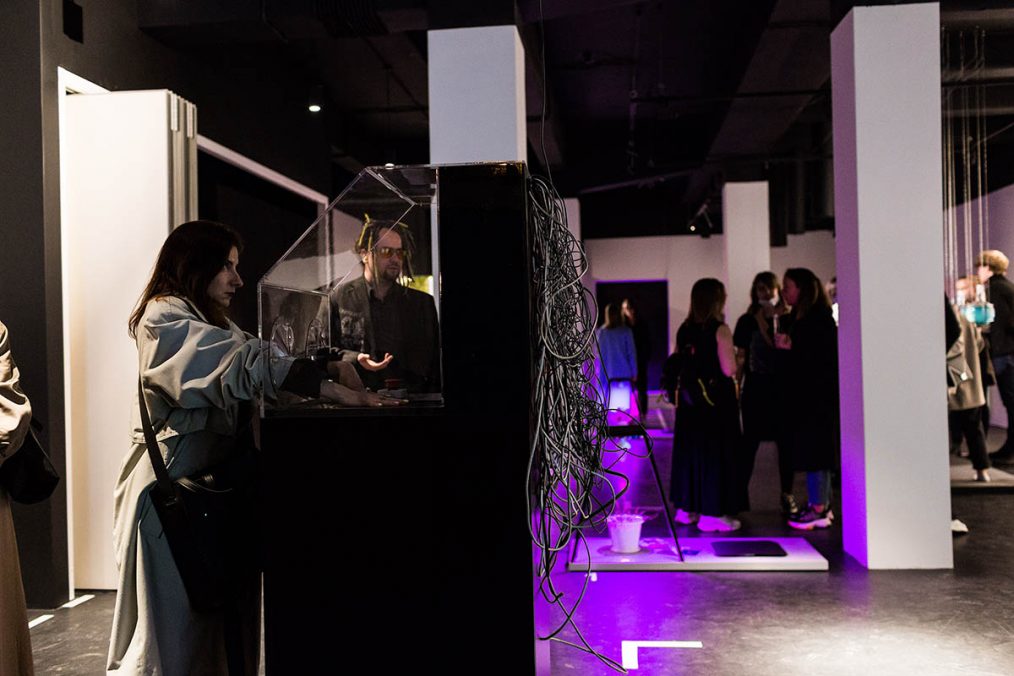
Physarum-fortuneteller, AIR gallery 2020
What is a speculative design for you? It would be interesting if you would explain this departing from the example of DIVA MERDÈ.
Speculative design for us is a field where we can discuss the potential future of technological progress in a fun and non-binding way. These scientific breakthroughs change the world around us, but the speed of these changes is so fast, that we as people far from modern science often do not even notice them. In the case of speculative design it is a great way to showcase in a profanatic manner the probable outcome of these achievements applied not only in everyday life, but in a new ethical framework of the future. And in Diva Merde we did exactly that. We took scientific findings about microbiome influence on human organisms from dietary preferences to emotional states and mixed it with present capitalistic ways of perceiving reality — how to make profit from microbiome? We amped this idea to absurd and decided to sell fecals of celebrities as a cosmetic procedure of microbiota transplantation. “Diva Merde — It’s what’s inside that counts.” We created and presented this project in frames of Design Hackathon organised by the chemical laboratory of ITMO University and Industrial Design Faculty of Steiglitz Academy in early May 2019. You can imagine our bittersweet shock when we saw an episode of South Park dedicated to this exact theme! (Episode aired on November 27, 2019)
What has been the rarest place in Russia that you have been showing your work?
Our first solo exhibition “Plants banging” took place outdoors. We had videos from our Vegetal porn shown at the Berthold center’s entrance in Victor Kudryashov’s 2 4 х 4 Gallery.
To paint a picture, 2 4 x 4 Gallery is basically 4 screens in the arch of a house. So when people get in or out of Berthold, they pass by video art. And, well, we were showing futuristic porn on these screens, so we think, we created a vegetal red light district in the city center.
The second unusual place was Trubetskoy palace. We got there thanks to curator Liza Klimko and the NUNC project. We had our Goldfish, The Residential complex shown there. The atmosphere was fancy and the audience was rich. Imagine us with our carps and second-hand fish tank trying to fit in. So we actually did (don’t mind two poor species who bravely fell in this battle). Famous russian artist Pokras Lampas noted our work as the best and many other cool people showed their interest. Fun part. When we were releasing fish to the residential complex, we didn’t take into account temperature differences between Neva and Trubetskoy palace. There were too many people inside, and the fish tank immediately turned into a boiling pot. Of course, we needed our residents alive, so we started looking for ice desperately. There was a sushi place nearby. We crazily ran in, begging for some ice. Two nice ladies promptly helped as if they knew the installation opening in the palace depended on their ice cubes. Somehow or other, we chilled our fishies and everything got normal.
Online world: OVR, online art fairs, O openings, O studio visits (…). How do you see this moment, and would you like to show in such a context?
It’s a really good question. Right now art is becoming just an area without any particular context. Contemporary art is very hybrid and it requires collaboration. In traditional art we face such concepts as subjectivity, artist and spectator, vision and so on. All this refers to the result of the artist’s work rather than to the process. Contemporary (non-traditional) art is very procedural. And more importantly, the boundaries between artist and viewer are blurred. Everyone participates. Imagine creating an interactive computer-based object without an artist conceptualizing and promoting it. Without a programmer writing code. Without an engineer, assembling it all together. And of course without people, using it, touching, trying to figure its meaning out. Talking of science art, a lot of really great projects required many years and multidisciplinary specialists to be completed. Take Labour by Paul Vanouse, Edunia by Eduardo Kac or !brute_force by Maja Smrekar. The last is still ongoing. The same with galleries, museums and residencies. People don’t build exhibition spaces anymore — they create multidisciplinary hubs. ITMO University, HSE University opened their art programs, exhibition spaces, residencies and lecture halls to motivate young artists to collaborate, not to produce and be exposed. As for BIOROBOTY 019, we don’t mind different contexts. Thankfully, we always get interesting offers from institutions and curators.
What are you currently working on?
Recently we launched our largest installation Bus stopochka and still are working out its possible future. We did this project together with curator Anna Zavediy and Paper journal for the big Science Bar Hopping event. Bus stopochka is an event-specific installation about the future and quasiscience. We bought a real bus stop, covered it with pseudoscientific flyers, posters and announcements. The scoreboard on the stop showed fake stops and directions like „bitcoin rate square“ and „bright future“. We also invited graffiti artists Johnny Napricole and Saone to paint the stop as if it was vandalized. It was located in Sevcabel Port, right near the entrance. So almost every passerby stopped to take a picture, to leave a tag, to chill. When we were installing, random people used to stop to chat and to help us. It was amazingly participative. Recently, several amazing musicians gave performances at our bus station. These are OLIGARKH, Discours Synthetique and aokiee (Vasily Bakanov) vs IEEE1394 (Alexey Grachev). So originally we made it as a participative art-object but now it seems like we’re going to use it as a space for events. For example, lately Bus stopochka was an official part of a big festival Stereoleto 2020 and an unofficial part of the Economical forum. Now one big university and cool bar want the installation to themselves.
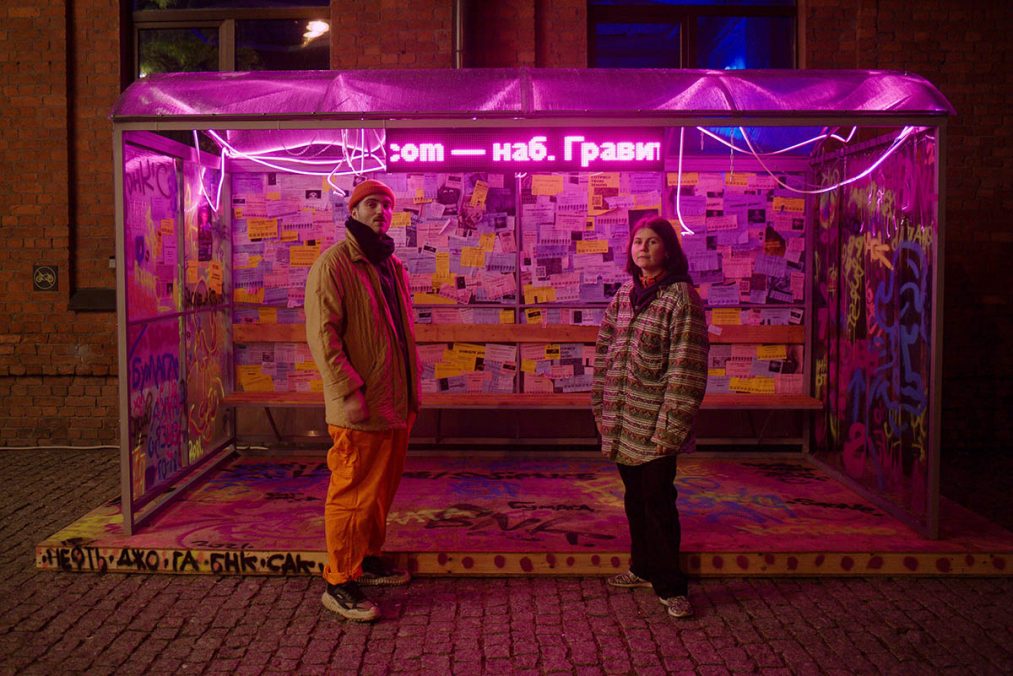
Bus stopochka and her proud parents (Sveta and Anton), Sevcabel port 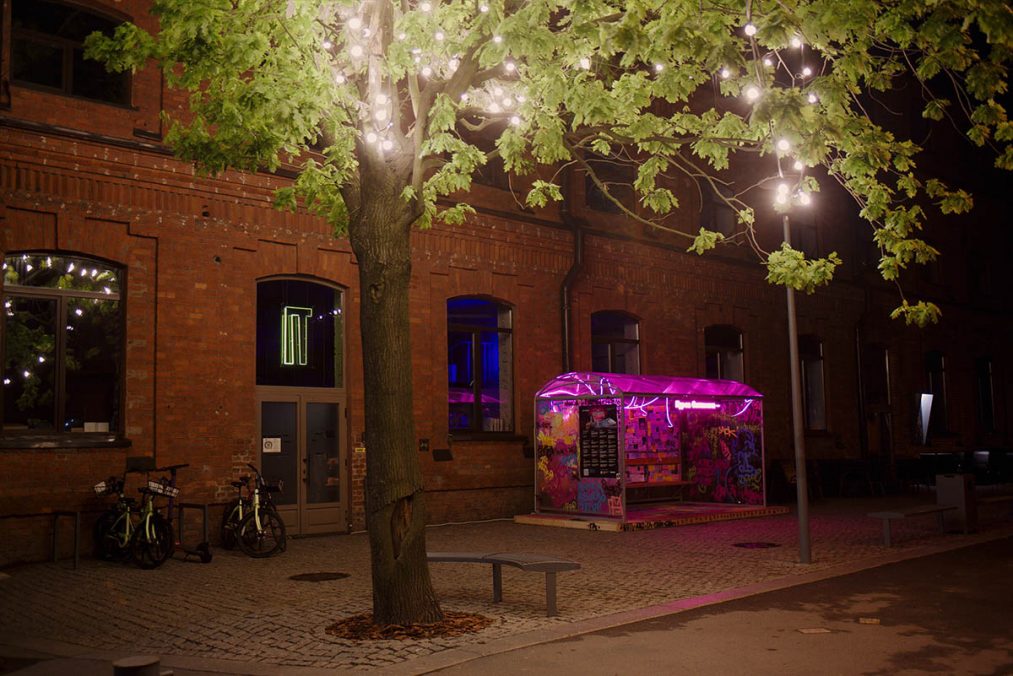
Bus stopochka, Sevcabel port 2021
If you would be invited from an art fair, example from COSMOSCOW, Art Basel or FIAC, what kind of work could you imagine for such a context?
Hard one… Maybe something provocative, fun, interactive and participative. Such works really help to be “in the same room” with people conceptually and physically. Especially at art fairs. Your work is to involve people, to tell them something, even if you are just selling. So why not go with participation?
Four places you would like to show in the future.
• Venice Biennale, to die in peace • Angarsk and Vologda cities, because Vika’s and Alena’s families are there. As kids we sure want our parents to be proud • Fondation Fiminco in Romainville, France. We wanted to go there SO BAD this year, but weren’t accepted • NY, because we want to visit the USA and how else would we get our visas accepted?
Bioroboty 019 – www.bioroboty019.com
Instagram, Youtube
Cornelius Wildner (*1970) is a Vienna-based sound artist and music technologist. He deals with ephemeral sounds, field recordings, archiving, live performance, analog and digital synthesis. At the same time, he collaborates with artists from different genres.
About the Interviewer: Erka Shalari (*1988, Tirana) is a Vienna-based art author. She focuses on discovering unique artistic positions, unconventional exhibition spaces, and galleries that have deliberately broken new ground in their working methods. In this regard, she relies on unorthodox publishing practices, coupling these with a nonchalant manner of writing. The work oscillates between articles for magazines, exhibition texts and press releases.



